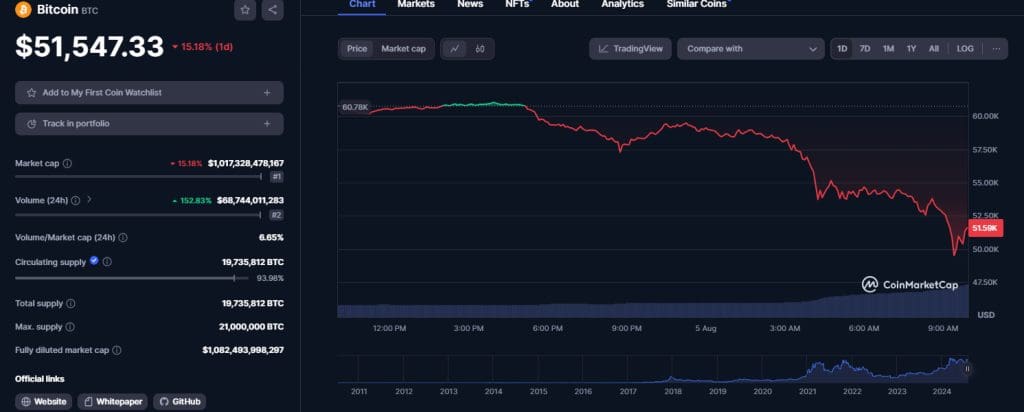Ethereum Wallet Growth Hits 2024 Low Amid Spot ETH ETF Launch
Celestia, a layer-1 data availability network, is rapidly gaining market share in onchain data storage, challenging Ethereum's dominance. Concurrently, the number of new Ethereum wallet addresses has reached its lowest level this year, influenced by the launch of spot ether ETFs in the U.S. market. Meanwhile, Tether CEO Paolo Ardoino has reiterated his preference for Bitcoin over Ethereum for the company's reserve allocations, emphasizing Bitcoin's immutability and limited supply.
Ethereum Wallet Growth Slows to 2024 Low Amid Spot Ether ETF Launch
The Ethereum network has hit a significant milestone, though not in the direction many investors would hope for. The number of new Ethereum wallet addresses has reached its lowest level this year. This decline follows the recent launch of spot ETH ETFs (exchange-traded funds) on the U.S. stock market, suggesting a shift in how investors are gaining exposure to the cryptocurrency.
According to on-chain data, the seven-day moving average of new Ethereum wallets has plummeted to its lowest point since December 2023. While this figure remains above much of the 2023 average, it marks a notable downturn in new user engagement on the Ethereum network. This decrease isn't confined to new wallets alone; the average number of active Ethereum addresses and transactions have also seen declines, both hitting nearly six-month lows.
The correlation between the launch of spot Ethereum ETFs and the decline in new wallet addresses raises intriguing questions about investor behavior. Spot Ethereum ETFs offer a regulated, accessible way for traditional investors to gain exposure to the leading altcoin without the complexities of managing digital wallets and navigating cryptocurrency exchanges. The convenience and security of these financial products might be diverting potential new Ethereum users away from direct token purchases.
Comparative Performance: Solana and Bitcoin
While Ethereum grapples with declining new addresses, its rival Solana is experiencing a contrasting trend. Solana has seen an uptick in new addresses, driven by the rapid growth of its decentralized exchange (DEX) ecosystem. Solana’s network, known for its high-speed transactions and lower fees, is becoming an attractive alternative for users, particularly with the continued interest in memecoins.
Bitcoin, the largest cryptocurrency by market cap, is also witnessing an increase in new addresses, despite the broader market downturn. However, this growth in wallet numbers hasn't translated into higher fees or significantly increased on-chain activity, indicating that the new wallets might not be contributing much to transaction volumes or network utility.
The launch of spot ETH ETFs marks a significant development in the cryptocurrency market, providing a bridge between traditional finance and digital assets. For Ethereum, this could mean a shift in how it measures growth and engagement. While new wallet addresses and on-chain activity have historically been key indicators of network health, the introduction of ETFs suggests that off-chain financial products could play an increasingly important role.
For investors, the emergence of Ethereum ETFs offers a new avenue for exposure, potentially reducing the necessity for direct interaction with the Ethereum blockchain. This shift might lead to a more mature market where institutional investment tools complement traditional on-chain participation.
However, the competition from networks like Solana and the evolving dynamics of the Bitcoin network suggest that Ethereum must continue to innovate and address user needs to maintain its position in the market. Enhancements in scalability, transaction speed, and cost-efficiency will be crucial in attracting and retaining users who might otherwise be swayed by newer, faster networks or convenient financial products like ETFs.
Celestia Poised to Overtake Ethereum in Onchain Data Storage
Celestia, a layer-1 data availability network, is rapidly approaching a pivotal milestone in the blockchain industry. According to Blockworks Research, Celestia is on track to surpass Ethereum as the leading network for onchain data storage. Since May, Celestia has been steadily increasing its market share from around 20% to approximately 40% by July 31, indicating a significant shift in the data availability landscape.
Launched in 2023, Celestia has positioned itself as a modular data availability network designed to facilitate the secure launch of individual blockchains. This emphasis on data availability places Celestia in direct competition with Ethereum, the current leader in Web3 settlement layers. The growth trajectory of Celestia demonstrates its potential to reshape the competitive dynamics within the blockchain sector.
Celestia's modular architecture offers several advantages, particularly in terms of cost-efficiency and scalability. As the network continues to gain traction, its appeal to developers and enterprises seeking efficient data storage solutions becomes more apparent.
In March, Ethereum introduced the Dencun upgrade, which included ”blobs,” temporary offchain data stores aimed at reducing costs for layer-2 scaling networks such as Arbitrum and Base. These blobs are stored on Beacon Chain nodes for approximately two weeks, allowing validators sufficient time to confirm data accuracy and post attestations on the mainnet. This method provides significant cost savings, which Ethereum creator Vitalik Buterin expects to surpass 98%.
Despite these innovations, Ethereum's transaction fees often remain higher due to the complexity of smart contract interactions. A report by staking platform Figment highlights that while Ethereum's fees can be reduced through Dencun's upgrades, Celestia's modular architecture generally offers even lower fees. The efficient design of Celestia supports high throughput and reduces congestion, making it an attractive option for data storage.
Competing Data Availability Solutions
Celestia is not alone in challenging Ethereum's dominance in data availability. Other notable contenders include EigenLayer and Avail. EigenLayer, which launched its restaking protocol EigenDA in April, and Avail, a data availability protocol spun off from Polygon in July, are both vying for a share of the market. These emerging solutions further intensify the competition and drive innovation in the data availability space.
According to Dan Smith, Blockworks’ data analytics manager, even as rivals like Celestia gain ground in data storage, Ethereum is likely to retain its position as Web3’s premier settlement layer. ”Ethereum remains dominant in decentralization, stables, and total value locked (TVL), which is what a settlement layer needs,” Smith stated in a post on X.
The blockchain industry is witnessing a transformative phase, with Celestia's rise challenging Ethereum's longstanding supremacy. As Celestia continues to grow its market share, it will be crucial to observe how Ethereum adapts and evolves in response to this new competition. The advancements in data availability solutions by Celestia, EigenLayer, and Avail are poised to drive further innovation and efficiency within the blockchain ecosystem, ultimately benefiting developers, enterprises, and end-users alike.
Tether CEO Paolo Ardoino Rejects Ethereum Allocation in Favor of Bitcoin
In a recent social media post, Tether CEO Paolo Ardoino has made it clear that the company will not be allocating any portion of its profits to Ethereum, the second-largest cryptocurrency by market cap. Instead, Ardoino reaffirmed his preference for Bitcoin, citing its immutability and fixed supply as key reasons for this decision.
”Bitcoin is immutable. Only 21 million coins. Easy choice,” Ardoino stated, emphasizing the unique characteristics that make Bitcoin an attractive asset. This sentiment is consistent with Tether’s strategy announced last May, where the leading stablecoin issuer revealed plans to allocate 15% of its profits toward purchasing Bitcoin. The objective behind this move was to fortify and diversify Tether's reserves, leveraging Bitcoin's reputation as a ”long-term store of value with substantial growth potential.”
Tether's most recent quarterly report highlighted a record-breaking net profit of $1.3 billion. Despite this impressive figure, the company's Bitcoin reserves have remained unchanged. Ardoino later clarified that Tether's investment arm did indeed purchase Bitcoin in 2024, ensuring the company's commitment to its previously stated strategy.
This is not the first instance where Ardoino has voiced his criticism of Ethereum. Following the much-anticipated Merge upgrade in 2022, Ardoino expressed skepticism about Ethereum’s capability to rival Bitcoin, accusing the blockchain of frequently shifting its narratives. His latest comments continue this critical stance, particularly in light of Ethereum's recent performance.
In his post, Ardoino pointed to Ethereum’s declining performance against Bitcoin over the past few years. The ETH/BTC pair has dropped 45% since peaking at 0.088 in December 2021. This decline brings attention to the challenges Ethereum faces in maintaining its position relative to Bitcoin.
Ethereum's Market Dynamics
In May, Ethereum experienced a significant price spike following the unexpected approval of various spot ETFs. However, this surge was short-lived as the flagship altcoin struggled to sustain its momentum. The future price action of Ethereum now heavily depends on the volume of inflows it receives. So far, these financial products have had a lukewarm reception, largely due to outflows recorded by Grayscale's product.
Ardoino’s remarks also highlight the broader market dynamics and the contrasting fortunes of Bitcoin and Ethereum. While Bitcoin continues to be seen as a secure, long-term investment with limited supply, Ethereum's evolving technology and frequent updates appear to add a layer of uncertainty, affecting investor confidence.
Tether's decision to prioritize Bitcoin over Ethereum for its reserve holdings signals a strategic focus on stability and long-term value preservation. By investing in Bitcoin, Tether aims to leverage the cryptocurrency’s established reputation and intrinsic value properties. This move may also reflect a cautious approach toward assets that are perceived as having higher volatility or less predictable development trajectories.
As the leading stablecoin issuer, Tether’s investment choices are closely watched by the market and can influence broader investor sentiment. The company's robust profit generation and strategic allocations are critical for maintaining confidence in its stablecoin, USDT, which is widely used across the cryptocurrency ecosystem.





